Can’t help but wonder how Christmassy it is, exactly, to get all pissed off because someone wished you happy holidays.
Yearly Archives: 2011
Conclusion
The Yellow Shark, An Appreciation. Merry Zappadan.
This is of course not Zappadan Eve (which actually falls on Dec. 20, not Dec. 3, my friends, I don’t know why, but that’s what Mark H has decreed) or even The Grand Wazoo Birthday, so we are not wrapping on Zappadan yet. I have it in my head that I might still want to write something about Don Sugarcane Harris maybe, though I might save that for Zappadan 2012. Haven’t decided yet. Maybe I’ll just post some videos of St. Alphonso’s Pancake Breakfast. I’m not sure how I’ll close out this auspicious holiday.
But I do need to close this portion of the project somehow. So let’s talk about what The Yellow Shark is all about.
I have enjoyed listening to The Yellow Shark, immensely. I have spent many wee hours with headphones on, trying to find nuances and interesting things to discuss here. And I can tell you that I personally think The Yellow Shark is comprised of a few crucial pieces of story.
First and foremost, The Yellow Shark is about the musicians. This Ensemble Modern was a dedicated, tenacious group that seemed to care about nothing but the music, period. Zappa himself didn’t think, for example, that “G-Spot Tornado” could ever be played by humans. It was the players who said screw that, Frank, we’re playing it, and they did, and they kicked its ass. This group was a class act like none you’ve ever seen, and I’d like to recognize that here. One way to accomplish that is to point them out by name. It’s the least I can do. As from the liner notes of The Yellow Shark, the players were:
Peter Rundel (Conductor, Violin), Dietmar Wiesner (Flute), Catherine Milliken (Oboe, English Horn, Didgeridoo), Roland Diry (Clarinet), Wolfgang Stryi (Bass Clarinet, Contrabass Clarinet, Tenor Saxophone), Veit Scholz (Basoon, Contrabasson), Franck Ollu (Horn), Stefan Dohr (Horn), William Formann (Trumpet, Flügelhorn, Piccolo Trumpet, Cornet), Michael Gross (Trumpet, Flügelhorn, Piccolo Trumpet, Cornet), Uwe Dirksen (Trombone, Soprano Trombone), Michael Svoboda (Trombone, Euphonium, Didgeridoo, Alphorn), Daryl Smith (Tuba), Hermann Kretzschmar (Piano, Harpsichord, Celeste, Dramatic Reading), Ueli Wiget (Piano, Harphsichord, Celeste, Harp), Rainer Romer (Percussion), Rumi Ogawa-Helferich (Percussion, Cymbalom), Andreas Böttger (Percussion), Detlef Tewes (Mandolin), Jürgen Ruck (Guitar, Banjo), Ellen Wegner (Harp), Mathias Tacke (Violin), Claudia Sack (Violin), Hillary Strut (Viola, Dramatic Reading), Friedemann Dähn (Violincello), Thomas Fichter (Contrabass, Electrocontrabass).
It is clear from this recording that the Ensemble Modern is a dedicated, talented, and serious group of musicians. As Gail Zappa said, they were Frank’s last band. They were also perhaps his best band, and I find their dedication to the music awe-inspiring.
I think The Yellow Shark is also about AAAAFNRAA, an acronym for “Anything Anytime Anywhere For No Reason At All.” I had not heard of this aesthetic until I began researching The Yellow Shark, but Gail Zappa mentions it often in discussing this project. I think the term itself requires no definition; it is clear to any Zappa fan what it means. It is why Hermann Kretzschmar is reading a library card on Everything Is Healing Nicely, which is how he ended up reading a form from Homeland Security on “Welcome to the United States,” which is a chilling, yet straightforward, piece. Do not underestimate the power of AAAAFNRAA. It can lead to good things.
I also think The Yellow Shark is about EIHN. They are very different recordings. But it is absolutely fascinating to hear these fine musicians in rehearsal. And there are a few tracks on this album that are just downright enjoyable. If you look up The Yellow Shark on Amazon, I highly suggest heading over to Barfko Swill to pick yourself up a copy of this. It is well worth the time.
I will be the first to admit that I prefer Zappa with a guitar in his hand rather than a baton and that the Zappa album that means the most for me is and always will be the very first one. But I enjoyed listening to and appreciating The Yellow Shark more than I possibly could have imagined. It is a wonderful way to gain new insight into the man, the artist, the composer, the guy we celebrate every year.
Not to mention that it’s one hell of a wonderful bunch of music.
Small kitteh in big chair.
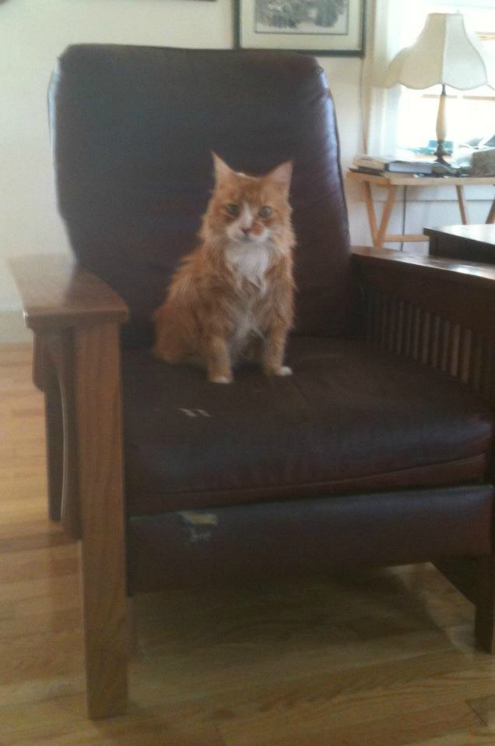
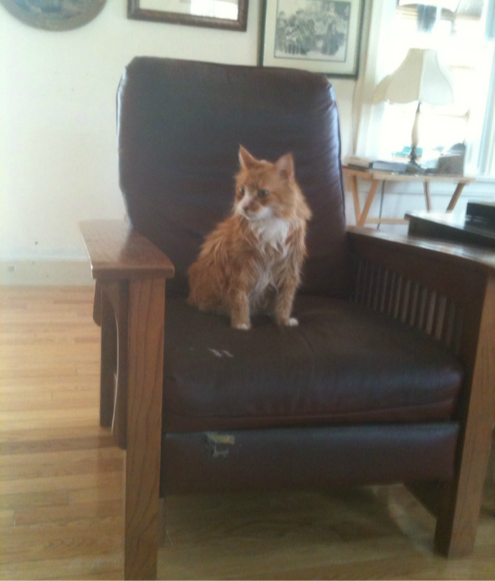
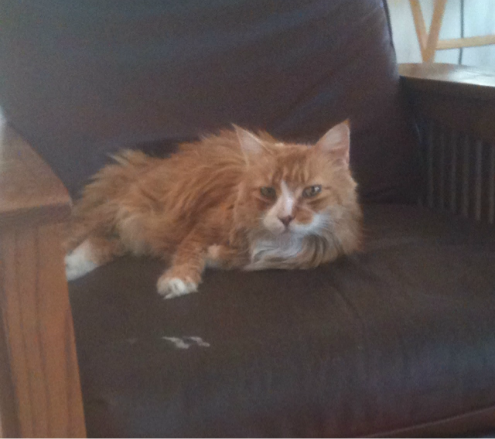
Meanwhile
It’s not every day you see someone lean out of the drivers’ side window of their car and vomit.
Dog Breath Variations/Uncle Meat
The Yellow Shark, An Appreciation. Merry Zappadan.
At the time they were interviewed for the Yellow Shark liner notes, Ensemble Modern Director Peter Rundel was not aware that the “Dog Breath” set had words.
Therein:
Primer mi carucha, chevy 39
Going to el monte legion stadium
Pick up on my weesa, she is so divine
Helps me stealing hubcaps, wasted all the timeFuzzy dice, bongos in the back
My ship of love is ready to attack
“It’s interesting what you say about it having text, the words,” Rundel said. “Very often you really have the impression of a speaking quality of his music, even if there are no words. The music speaks very much.”
The Dog Breath theme is fairly universal in the project/object. Frank Zappa albums on which it has appeared include: Uncle Meat, Electric Aunt Jemima, Disconnected Synapses, Just Another Band From L.A., Swiss Cheese/Fire!, Live In Melbourne, You Can’t Do That On Stage Anymore Vol. 2, Bubble Cream Cheese in Dog Meat, The Dub Room Special, and, of course, The Yellow Shark.
I love this arrangement. People say Zappa strikes them as a Stravinsky. In this arrangement, I hear Berlioz; I hear the start of Symphonie Fantastique, which also starts out as a ride on a swamp boat but then shoots a flare into the sky it brightens so dramatically. This may very well be the most bright, beautiful arrangement in this collection.
It might of course be helpful to listen to the source material. That is one nice thing about spending some time with The Yellow Shark if you never have. It can be tangential, causing you to need to listen to many other parts of the object. For instance, before 2011, I am ashamed to say, I was not much familiar with Uncle Meat. But to listen to and appreciate The Yellow Shark, Uncle Meat was certainly a necessity.
Here’s a really nice recording from 1973, which starts with Exercise 4, which, yes, we will be considering later. This is gorgeous, though:
It is also interesting how similar the arrangement is to the one some 20 years later. It is nearly the same performance, but with different instrumentation.
By the way. When these kids these days are looking for a bit of a challenge, guess what they seem to pick? Lookit these youngsters nail this piece. I love this.
Intro
The Yellow Shark, An Appreciation. Merry Zappadan.
::applause:: Thank you, thank you. Thank you, thank you, thank you, and thank you. I understand there is a sign in the audience that once again says “what’s the secret word for tonight?” The secret word for tonight is: ::sound of toy laser guns::. Now, let’s get serious, ladies and gentlemen. I know you came here to see really fine performances by a really fine modern music ensemble conducted by a really fine conductor. And here comes the fine conductor now: Peter Rundel, ladies and gentlemen!
And if you feel like throwing underpants onto the stage, put ’em over there.

The first thing the liner notes of Zappa’s The Yellow Shark discuss is the genesis of the project’s unlikely name. It emerged from a piece of art an L.A. artist had mailed to Zappa in 1988, a surfboard carved into a shark that had, apparently by the bloodied mouth, been caught. Andreas Mölich-Zebhauser, Manager of the Ensemble Modern at the time, latched onto the object.
…For me it was completely clear that it must become the symbol of our event, of our tour! Because the yellow shark, he’s so pregnant with some of Frank’s characteristics. He’s very hard and a little poison, but on the other hand, he’s very friendly and charming. Two things which Frank can be very often: poison for bad people, charming for good ones! Of course, also it’s such a good logo.”
Page 140 of The Real Frank Zappa Book has one of my most favorite Frank Zappa ruminations of all time, ever. It says:
The most important thing in art is The Frame. For painting: literally; for other arts: figuratively—because, without this humble appliance, you can’t know where The Art stops and The Real World begins.
You have to put a ‘box’ around it because otherwise, what is that shit on the wall?
The frame. Context. Naming things. In his family, Zappa was the namer of things, and, quite nefariously, of the people he brought into the world. Yes, he named her “Moon Unit,” get over it. For the record, Zappa addressed this directly on Arsenio Hall in February 1989: “Unit” is about Zappa’s family values, everybody. Get over it.
So how appropriate and synergistic was it that Andreas Mölich-Zebhauser saw this ridiculous sculpture, he was struck by it and adopted it as the frame? The Yellow Shark. It’s perfect, because it lives right in the middle of the Venn diagram of all the places this music can live. Some of these pieces are incredibly straightforward. Others are laugh-out-loud farce. While the rest of the pieces, in fact, most of the pieces, are abstract and challenging.
Sorta like a yellow shark carved out of a surfboard. I guess. Either way, regardless, whatever. The yellow shark is the frame.
We’ll start listening tomorrow, and I’ll write down some observations of my own as we go (so much for dancing about architecture) and please, leave comments if you like. Any writing I do here is by no means a conclusion. I have only scratched the surface, and I am well aware of it. The answer to the question down there is steam, by the way. So please. Discuss.
In the meantime, you can warm up with this: The Perfect Stranger. (Wiki is here.)
Peace in our time.
Kitteh haz been sleeping on my laundries. My laundries should not be on floor of course, but that’s beside the point. So when I was at a certain box store today, I came across something called the “Catnip Lounger.” It’s a kitteh bed with a packet of catnip attached. I threw it in my cart next to my new ice scraper. I brought it home and cut off the packet of catnip and threw it down on the floor. Kitteh lunged for it and was enjoying it within minutes.
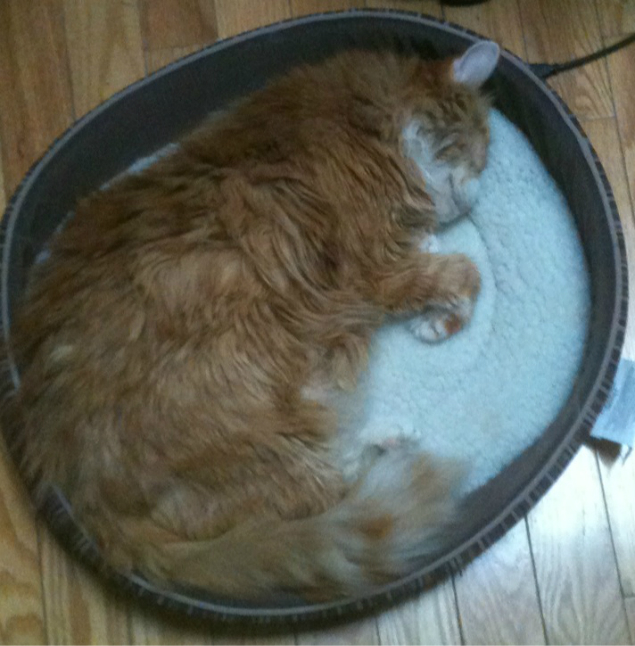
Problem iz that kitteh #2 iz all like WHERE’S MAH BED? HUH? I’MA TAKE THIS BED FROM YOU KITTEH! And was fixing to do so, and kitteh #2 is larger and more spry than iz kitteh.
So I drove back to the certain box store. Thankfully, they haz another one just like it.
Two happy kittehz now sleepin’ in here. Peace in our time.
Ready.

I’m gonna pepper spray everyone I know with love and gratitude this week. Wait. That sounds wrong for a reason or two.
Wakey Wakey
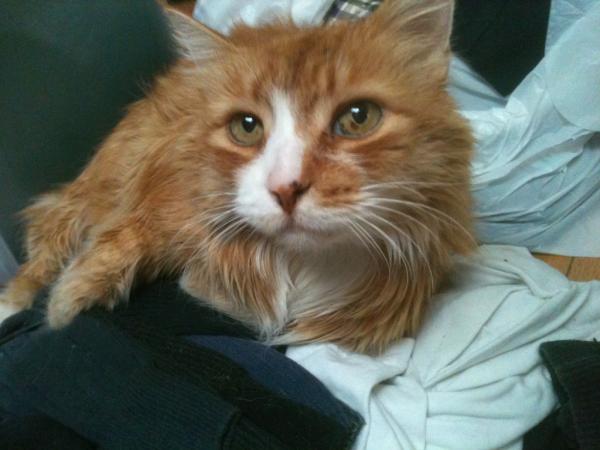
Had a case of sleepinsia this morning. Heard scratching on my bedroom door. Assumed it was puppeh. It was not puppeh. It was kitteh.
Good Doggie
My new insurance agent’s office keeps a pooch, this elderly, fat, patchy cocker spaniel mutt with a cyst on his back, named “Lucky.” As I waited this morning, Lucky came over, gave me a sniff, then rolled onto his back and insisted on a belly rub. I rubbed the dog’s tummeh and was certain I had picked the right insurance agent.
Good Doggie
My new insurance agent’s office keeps a pooch, this elderly, fat, patchy cocker spaniel mutt with a cyst on his back, named “Lucky.” As I waited this morning, Lucky came over, gave me a sniff, then rolled onto his back and insisted on a belly rub. I rubbed the dog’s tummeh and was certain I had picked the right insurance agent.
